


Leonia Retreat Route Sign
Fort Lee Rd. and Oratam Ter.
Map / Directions to the Leonia Retreat Route Sign
Map / Directions to all Leonia Revolutionary War Sites
On the night of November 19-20, 5000 British and Hessian forces under General Cornwallis crossed over the Hudson River from New York City, disembarking about six miles north of Fort Lee at Lower Closter Landing, causing the American troops to abandon their encampment at Fort Lee. This began a twelve-day retreat across New Jersey, arriving on December 2 in Trenton, from where they spent five days moving all the troops and supplies across the Delaware River into Pennsylvania.[1]
This wooden sign notes the use of the road during the early part of the retreat. In addition to this sign, there is the series of markers that begin in Fort Lee that traces Washington's retreat route throughout Bergen County.
See the Fort Lee page of this website for a detailed description of the events surrounding Fort Lee and the evacuation and invasion.


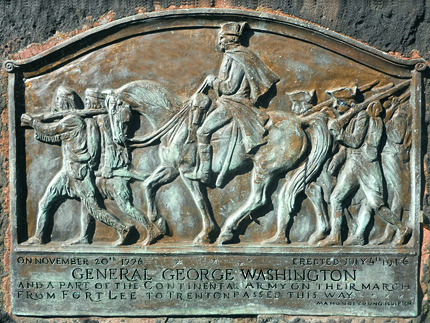
General Washington Retreat Monument
181 Fort Lee Rd.
In front of the Presbyterian Church
Map / Directions to the General Washington Retreat Monument
Map / Directions to all Leonia Revolutionary War Sites
This bas relief sculpture sits in front of the Presbyterian Church in Leonia. It depicts General Washington and soldiers in the November 20, 1776 retreat from Fort Lee to Trenton that passed this way. It is surrounded by shrubbery and is easy to miss when driving or walking by, unless you are looking for it. The sculpture was erected July 4, 1916, and was sculpted by Mahonri Young (1877 – 1957), [2] who lived for a time in Leonia, just around the corner from here on Prospect Street. He was the grandson of Brigham Young. [3]

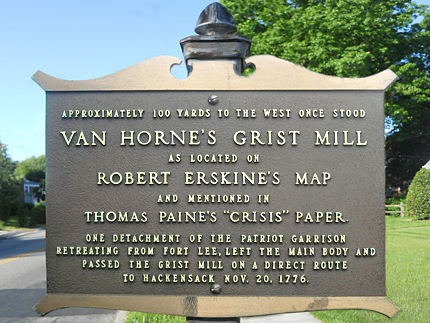
Van Horne's Grist Mill Site
Grand Ave., near the corner of Lakeview Ave.
Map / Directions to Van Horne's Grist Mill site
Map / Directions to all Leonia Revolutionary War Sites
Thomas Paine was the author of important pamphlets during the Revolutionary War. The first of these pamphlets, Common Sense, was published in early 1776, and it helped move public opinion in the colonies towards independence.
In July 1776, Paine joined up with the American Army, and in September he became an aide to General Nathanael Greene. During this time he also acted as a war correspondent, sending his eyewitness accounts to be published in the Pennsylvania Journal.
Paine was with the American army when they evacuated Fort Lee on November 20, 1780, and traveled with them as they retreated across New Jersey. This experience inspired him to write a series of pamphlets titled The American Crisis (also known as The Crisis), which began with the now famous phrase, "These are the times that try men's souls."
The first American Crisis pamphlet makes several mentions of New Jersey (referred to in the pamphlet as "The Jerseys") including a reference to a grist mill (a mill used to grind wheat into flour) that stood near here. The historic sign here notes that, "Approximately 100 yards to the west once stood Van Horne's Grist Mill as located on Robert Erskine's Map and mentioned in Thomas Paine's 'Crisis' paper. One detachment of the patriot garrison retreating from Fort Lee, left the main body and passed the grist mill on a direct route to Hackensack Nov. 20, 1776." [4]
The passage referred to in The Crisis reads:
"Our first object was to secure the bridge over the Hackensack, which laid up the river between the enemy and us, about six miles from us, and three miles from them. General Washington arrived in about three-quarters of an hour, and marched at the head of the troops towards the bridge, which place I expected we should have a brush for; however, they did not choose to dispute it with us, and the greatest part of our troops went over the bridge, the rest over the ferry, except some which passed at a mill on a small creek, between the bridge and the ferry, and made their way through some marshy grounds up to the town of Hackensack, and there passed the river." [5] (Emphasis added)
There are two statues of Thomas Paine in New Jersey. One is located in the Morristown Green, and the other is in Bordentown.

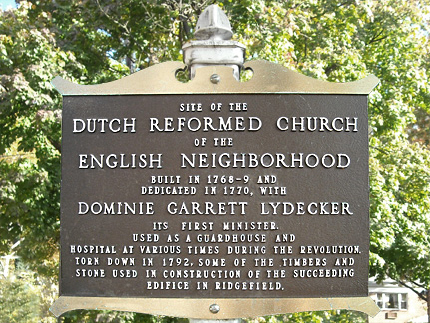
Dutch Reformed Church of the English Neighborhood Site
Hillside Ave. and Grand Ave.
Map / Directions to the Dutch Reformed Church site
Map / Directions to all Leonia Revolutionary War Sites
This plaque marks the site of Dutch Reformed Church of the English Neighborhood, which was constructed in 1768-1769 and dedicated in 1770. Its first minister was Gerrit Lydekker (also spelled Garrett Lydecker or Gerrit Leydecker). Lydekker remained loyal to the British in the Revolutionary War, and in 1776 he fled the church for British-occupied New York City. [6]
The church was used as a hospital and guardhouse on several occasions during the war.
The church was torn down in 1792. A new church building was constructed in Ridgefield the following year, using some of the stones and wood from the original church. [7]

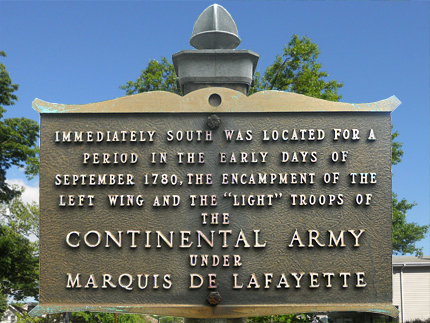
Lafayette Encampment
Fort Lee Rd. - Across from Leonia Library
Map / Directions to the Lafayette Encampment
Map / Directions to all Leonia Revolutionary War Sites
During the period of August 23 - September 20, 1780, the Continental (American) Army encamped in Bergen County. This plaque marks the location where a portion of the army, the light infantry serving under General Marquis de Lafayette, camped at the beginning of September. [8]
On September 4, the army would move several miles further inland, to west of the Hackensack River. At that time, Lafayette's light infantry would encamp in the area of what is now Van Saun Park in Paramus, and remain there until September 20, with General Lafayette making his headquarters by Soldier Hill in Oradell. [9]

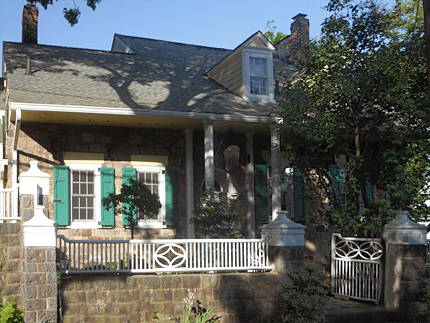

Cole-Allaire-Boyd House
Grand Ave. and Prospect St.
Map / Directions to the Cole-Allaire-Boyd House
Map / Directions to all Leonia Revolutionary War Sites
This house, which was built circa 1765, is the oldest surviving house in Leonia. Before and for part of the Revolutionary War, it was the home of Samuel Cole, an ardent Tory. [10] (Tories were Americans who remained loyal to the British during the Revolutionary War.) He was known to have betrayed the whereabouts of local militia to the British. The following account by Bergen County militiaman Benjamin Cole describes his capture by the British due to Samuel Cole:[11]
"On the 6th day of September 1781, myself with five others, while in arms at Closter, was taken by surprise of the enemy, who was led to the place of our nightly seclusion, to which we were accustomed to retire, when off of duty, not daring to sleep in our houses. This place of seclusion was in the thick woods, and near it were driven our horses and cattle for safety. They were led to it by one Samuel Cole, who perpetrated this act of treachery: he was of Closter, a Tory resident of our neighborhood. He led on the enemy in his own person, we were made prisoners, though not then in actual enlistment, and with our horses and cattle were hastened down to this City, where we were put in prison and held for seven weeks. Our exchange was effected nearly the exact time Cornwallis was taken [this refers to the surrender of British General Cornwallis at Yorktown, October 19, 1781], we returned to our homes, and I entered on military duty in my company beat as theretofore and continued therein till the end of the war. At our capture, one Elias Day was pierced through the thigh with a bayonet, and myself was slightly wounded in the arm with a like weapon, by Captain William Harding the chief of the gang; who saith, it was only his intention to make me feel a little for abusing Sam Cole, their guide."
In 1916, artists Rutherford Boyd and Harriet Repplier Boyd bought and renovated the house, and it has remained in the Boyd family since. Their son David, who was also an artist, was a Leonia historian who gave historical tours of Leonia. [12]

1. ^ See the Alpine and Fort Lee pages of this website for more information about these events, along with accompanying source notes.
2. ^ Date and identity of Mahonri Young as the sculpture from the bottom of the relief.
3. ^ • Florence Nightingale Levy, American Art Annual, Volume 14 (Washington D.C. : The American Federation of Arts, 1917) Page 653
Available to be read at Google Books here• American Architect and Architecture, Volume 115 (1919) Page 426
Available to be read at Google Books here4. ^ Leonia NJ historic sign
5. ^ Thomas Paine, The American Crisis No. 1 ( 1776)
6. ^ For information about Garrett Lydecker his decision to remain loyal to the King of England, see:
Firth Haring Fabend, "The Reverend Gerrit Lydekker: From Coetus to Conferentie, An Explanation of 'What Happened'," in Barbara Z. Marchant, Editor, Revolutionary Bergen County, The Road to Independence (Charleston: The History Press, 2009) page 65-79
7. ^• The Bergen County Historical Society sign in front of the church in Ridgefield
• The bronze sign at the location of the original church building in Leonia
• National Register of Historic Places Registration Form for the English Neighborhood Reformed Church of Ridgefield, submitted July 16, 1998
Available as a PDF on the National Park Service /National Register of Historic Places website here.8. ^ Leonia NJ historic sign
9. ^ See the Paramus, and Oradell pages of this website for more information
10. ^ Leonia NJ historic sign
11. ^ Benjamin Romaine's 1835 pension application (National Archives No. W18839), reprinted in:
Todd W. Braisted, Bergen County Voices from the American Revolution (Charleston: The History Press, 2012) page 107 - 119 (The quoted text appears on page 112)• For an earlier incident involving Samuel Cole, see:
Adrian C. Leiby, Revolutionary War in the Hackensack Valley, The Jersey Dutch and the Neutral Ground, 1775 - 1783 (New Brunswick: Rutgers University Press) Page 121-12212. ^ • Carol Karels, Leonia (Images of America series) (Charleston: Arcadia Publishing, 2002) page 12
Available to be read at Google Books here
▸ The book shows a photo of the house before the restoration, and a drawing by David Boyd of the house as it looks now.• Maxim Almenas, "Saying Goodbye to David Boyd," NorthJersey.com, March 5, 2010